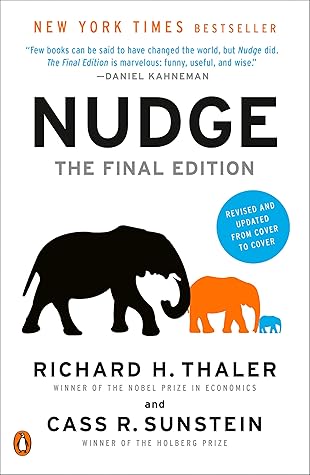More on this book
Community
Kindle Notes & Highlights
small changes in context can greatly influence schoolchildren, just as they can greatly influence adults.
so long as they are not harming others, people should be free to do what they like—and
The paternalistic aspect lies in the claim that it is legitimate for choice architects to try to influence people’s behavior in order to make their lives longer, healthier, and better.
way that will make choosers better off, as judged by the choosers themselves.
they should attempt to move people in directions that will make their lives better. They should nudge.
the planning fallacy—the systematic tendency toward unrealistic optimism about the time it takes to complete projects.
status quo bias, a fancy name for inertia.
The false assumption is that almost all people, almost all the time, make choices that are in their best interest or at the very least are better than the choices that would be made by someone else.
The first misconception is that it is possible to avoid influencing people’s choices.
reactance: when people feel ordered around, they might get mad and do the opposite of what is being ordered (or even suggested).
money is fungible,
merely because we think that most other people like it.
people were more likely to fulfill their goals if they had made explicit “implementation intentions.”
Who chooses? Who uses? Who pays? Who profits?
The most important modification that must be made to a standard analysis of incentives is salience.
In free markets, the answer is usually yes, but in important cases it can be no.
“work consists of whatever a body is obliged to do. Play consists of whatever a body is not obliged to do.”
partitioned pricing, which is to divide a price into components without disclosing the total, and drip pricing, which is to advertise only part of a price up front and withhold other parts until customers move toward finalizing their choices
Make It Easy.
use the term to mean this: any aspect of choice architecture consisting of friction that makes it harder for people to obtain an outcome that will make them better off (by their own lights).
asymmetry between the ease of joining and the pain of leaving an important part of their business model.
“shrouded attributes.”
when purchasing insurance, choose the largest deductible available.
those born earlier in the year (e.g., February) are more likely to face cost-sharing by the end of the year than those born later (e.g., September)—meaning they paid more for each drug out of pocket. While the change was small, about $10 per drug, patients cut back on their drugs, as in the previous study. But as medical science would predict, patients who cut back had a much higher risk of dying—about
prompted choice.
One useful fact: you are about three times more likely to be a patient in need of an organ than to be an organ donor.
As of November 2020, there were more than 108,000 Patients waiting for an organ transplant, mostly for kidneys, in the United States alone,
The U.S. government estimates that every day, seventeen people die waiting for a transplant.
Because each donor can provide as many as eight organs for transplant,
routine removal. In this regime, the state owns the rights to the body parts of people who are dead, and their organs can be removed without asking anyone’s permission.
presumed consent (or deemed consent). In a strict application of this policy, all citizens are presumed to be consenting donors unless they explicitly register as unwilling donors.
Presumed consent is an opt-out rule.
Gallup, more than 90 percent of Americans said they supported or strongly supported the donation of organs for transplant, but only 55 percent said they had registered as donors.
A primary function of prompted choice is overcoming procrastination, inertia, and limited attention.
When Americans buy a new iPhone or set up the health app for the first time, they are prompted to register as an organ donor via the Donate Life registry. From its start in 2016, this initiative has produced more than six million registrations so far.
So let’s try to be clear. Suppose the driver’s license application is administered online. If a response to the organ donation question is required, then the application will not be considered finished unless this question is answered. If it is merely prompted, then people can simply choose not to answer.*
Present bias. As we have seen, people tend to be much more concerned with now as opposed to later.
Salience.
you can’t even see them, you might not worry about them.
it may not be possible to insist that any particular event is attributable to climate change.
Efforts to reduce greenhouse gas emissions require the imposition of immediate losses. If everyone has to pay some new “climate tax,” loss aversion kicks in.
“tragedy of the commons.”
1954.5 He defined a public good as one that everyone can consume without diminishing others’ enjoyment.
if you make environmentally friendly choices in your life, everyone shares in the benefits you create, so you might not make those choices.
disclosure requirements can sometimes produce significant emissions reductions.
extremeness aversion: people tend to prefer options in the middle.
Active choosing is often a good idea, but in many domains, curation and well-designed defaults are a blessing. We should not wish them away.
Cooling-off periods are a relatively mild intervention.


